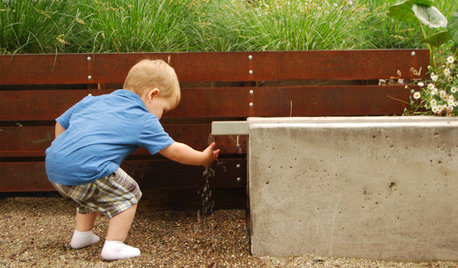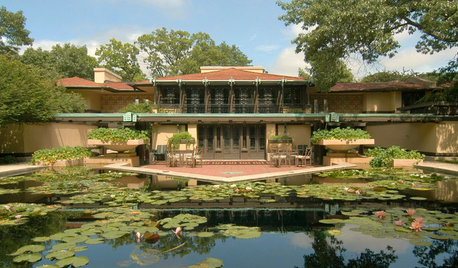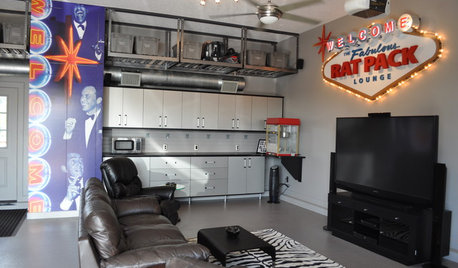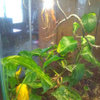Some extra thoughts that eluded me when replying to Sahoyaref's posting about planning her new set-up.
Fire-bellies usually come in two commonly available species - the well known 'Oriental' version with the brighter coloured topsides, and a drabber 'European' type - still with a firey underside. Females are drabber, but similarly sized to the males, in both species. They co-exist happily and easily interbreed. Care is identical. I wonder how many specimens in the trade are in fact hybrids...? Also, but far less common, there are Yellow-bellied toads in circulation, plus yet one further variant that I've never encountered at all. So, in theory, FOUR possible species, plus hybrids...
Fire-bellies need no extra heating under normal room-temperature conditions, but will still thrive in a warmer paludarium set-up, if that is what you require for your plants. Heating the water with a tiny wattage (25 to 50watts) aquarium heater-stat - to 23C, say - would conveniently achieve the temperature lift you'd be looking for, and the heat build-up towards the top of the paludarium would, in effect, give you another climatic zone to play with up there. Or you could leave well alone and just let the internal lights provide any ambient lift, plus a 'natural' cool down when the timer cuts off at night. As long as you don't chill them or cook them, there is a wide temperature latitude.
And talking of lights: do FB's need a special reptile-spectrum D3 light to help them synthsize skeleton-forming minerals? Most literature says they DO, others ignore the subject. My experience - with and without a special D3 tube - shows no difference either way, although I've always provided a Vitamin D supplement to the crickets in any case. For the record, plants grow nicely under D3 tubes - and the human eye can't detect any spectrum difference from any other cool white tube - so you can include one if you wish. How you tell at the plannning stage whether the frogs will ever choose to bask under that very spot once the paludarium is completed is another matter...!
Fire-bellies aren't really climbers like tree frogs, nor frequent swimmers in open water, nor do they eat while in water - but they will do all these things if they have to. It's just not their prefered lifestyle - so plan accordingly. The more varied and creatively designed the water and land environments, the more rewradingly the FB's behave. They love to pose and position themselves in relation to the other frogs, and it's really this endless social interaction that makes them such endearing reidents in your set-up. Plenty of little posing areas, both in and around the water...that's where cleverly positioned bogwood pieces really make a difference.
A friend of mine made a fantastic FB pauldarium, at phenomenal expense and on a zoo-standard scale. The water area was so large and deep that he was able to include sizeable tropcal fish, and the land area so topographically ambitious that it boasted fibreglass waterfalls of jacuzzi-like violence. When I first saw it I told him it was probably unsuitable for its intended occupants - the water was too deep and dangerous for the FB's, the waterfall too violent for the FB's to risk sitting in, and the terrain to steep for gentle pottering about and posing. But they loved it, and skillfully manouevred along the rapids without mishap! But I NEVER saw them venture into the fish pool area - it would seem they only like shallow, cluttered, boggy pools. Not deep open water.
The two challenges that really do need addressing, however, are maintenance and crickets. Designing in a convenient way of doing water changes is so important: occasional access to the filter pump and heater, but most of all a simple way to siphon out most of the water and replace it. You'll curse that you didn't prioritise this aspect right from the design stage if it later turns out to be difficult. Fortunately, I've found that a densely planted set-up needs relatively infrequent water changes - once established it will look after itself for a long time. Once a month would be sufficient, and I'd guess that even quarterly would be possible if everything is as it should be. Four or five FB's in a big pauldarium, with lots of immerse plants and beneficial biological activity to recycle the water...that's what you'd be aiming for. It's not like the chore of weekly water changes with fragile tropical fish. And the bigger the water volume, and the more surface area of land, plants, substrate and false-bottom that it trickles over, the better the recycling effect will be.
So, water changing is not necessrily the headache you might be imagining - as long as you have desiged well, have acccess, and have stocked realstically. But the crickets...now they ARE a bloody pain! The FB's will stay put, but the crickets will probably escape unless you've sealed all the gaps. Even then they'll often be escapees as you drop in regular food deliveries - they'll leap out before you can slide the door shut. And where are the crickets themselves going to be living, for the month between buying them and using them all up as frog food?
It would be easy to fill an entire essay-posting simply on cricket issues alone! Although four sizes of crickets are easily available (regular monthly mail order is convenient) the only sizes relevant to FB's are 'pinheads' and 'small' - all the rest will usually be ignored as being too big. And during the month that you're housing and feeding-up your regualar consignment of tiny crickets, a proportion of them will grow too big - inevitably you end up with a surplus of large fat crickets that are no use. Your pet store will probably trade these for a new batch of tiny crickets, as they always have a need for valuable bigger food sources, but obviously this won't work with a mail order arrangement. Just something to bear in mind: what are you going to do with the monthly giant cricket surplus?!
In fact, it turns out that the crickets are much more work than the frogs. Cleaning them out at least weekly is advisable, otherwise they start to smell a bit. I keep my crickets in the largest size of lightweight plastic critter tank, with snap-on lid. I line the floor with kitchen towl and provide a pot of wet cotton wool for drinking, plus a bowl of proprietary cricket food - in effect, you're really feeding the frogs with this nutruent-rich stuff and the crickets are just the means of getting it inside them. But the crickets grow fast and fat on it, and have (I hope) happy short lives nonetheless. I catch a few crickets inside a big plastic beaker that's got a pinch of D3 dusting powder inside, shake them around a bit, and drop them into the pauldarium. That's it - a complete frog diet. You can handfeed (they'll escape uneaten otherwise) the occasional worm, with specially smooth reptile tweezers, if you like - just as a treat or supplement. But the crickets will suffice if you prefer.
Not spoiling your life with the crickets - that's the part that I've never entirely succeeded with. We should talk again about all this and see how it's progressing.
Steve - Brighton, Sussex Coast, UK

















sahoyaref
angelo_s
Related Professionals
Anderson Landscape Contractors · Bridgeport Landscape Contractors · Middletown Landscape Contractors · Reisterstown Landscape Contractors · Nashville Fence Contractors · Burbank Fence Contractors · Clarksburg Fence Contractors · Lake Zurich Fence Contractors · Tulsa Fence Contractors · West Jordan Fence Contractors · Glen Burnie Window Contractors · Barrington General Contractors · Fargo General Contractors · Point Pleasant General Contractors · Rolling Hills Estates General Contractorssahoyaref
angelo_s
sahoyaref
joshua1229
Cdfortin
Cdfortin
joshua1229
deadhamster
Cdfortin
zoni
dpitts2_austin_rr_com
earth.water.air
nazz